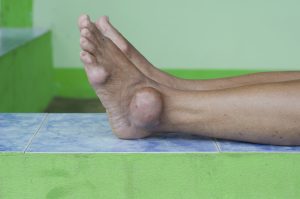Gout is a particular type of arthritis that targets the joints and tissues around the large toe and foot. Attacks of gout can happen sporadically, but they usually occur soon after waking up or during the night.
Advertisement
To have a better understanding of this form of arthritis, let’s look at causes, symptoms, risk factors and how to treat gout naturally.
Causes and symptoms of gout
Gout is caused by an accumulation of uric acid. Uric acid is the result of the body breaking down purines – substances naturally found in the body and the food we eat. Uric acid passes through the body through the kidneys and gets released in urine. When there is too much uric acid it can crystallize and surround joints and tissues. This can lead to redness, pain and burning sensations.
Symptoms of gout include:
- Joint pain – this pain is usually around the big toe. It may also spread to the ankle, foot and knees.
- Discomfort – some joint discomfort may last from a few days to a few weeks.
- Inflammation and redness – the affected joint or joints become swollen, tender, warm and red.
- Limited range of motion – decreased joint mobility may occur as gout progresses.
Progression of gout through four stages
Gout can progress in four stages: Asymptomatic hyperuricemia, acute gout, interval or inter critical gout, and chronic tophaceous gout.
Asymptomatic hyperuricemia: A person has high levels of uric acid in their body but they do not experience any gout-related symptoms. Treatment is not typically required at this stage and only slight damage of the tissue is caused.
Acute gout: Crystals have been deposited and there is inflammation and pain. Flare-ups last between three to 10 days which can be triggered by stress, alcohol and even cold weather.
Interval or inter critical gout: This is the period in between gout attacks. Urate crystals continue to be deposited.
Chronic tophaceous gout: This is the debilitating form of gout where permanent damage to the joint and the kidneys occurs. If a patient is receiving proper care it is rare that they will enter this stage of gout.
Risk factors of gout
Advertisement
Both men and women can develop gout, but there are risk factors that may increase the susceptibility of a person developing it. Risk factors of gout include:
- Eating foods that promote the production of uric acid – steak, seafood, sugary foods and beverages and alcohol
- Obesity – an overweight body will produce more uric acid
- Medical conditions – conditions like untreated high blood pressure or kidney problems increase the development of gout
- Medications – certain medications, such as those that treat hypertension or low-dose aspirin, may increase a person’s risk of gout
- Family history
- Age – risk of gout increases with age
- Surgery or trauma.
Natural remedies of gout
The good news is, even though gout can be painful, it is treatable. There are lifestyle changes and home remedies you can use to treat symptoms of gout. Here are natural ways to reduce gout:
- Drink coffee – the Mayo Clinic reports that coffee has been shown to help lower uric acid
- Eat cherries – studies have shown cherries to be associated with lower uric acid levels
- Drink baking soda in water – some studies have shown baking soda can help to relieve pain associated with gout. It’s important to note that baking soda is high in sodium. Consult your doctor first.
- Stay hydrated – the more water you consume, the more uric acid can leave the body through urination.
By following these natural remedies you can help alleviate the pain associated with gout. These tips might even prevent the onset of gout.

